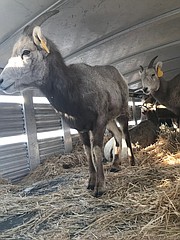Bighorns make the move to Plains
The Montana Fish, Wildlife and Parks recently helped boost numbers of the local bighorn sheep herd in Plains.
A team from the state wildlife agency braved the subzero temperatures of the extreme winter weather conditions south of Malta to transport the wild stock to Plains some 500 miles from their original habitat.
“With wind chill temperatures hovering around negative 45 degrees in mid February, FWP staff worked with a helicopter crew from Quicksilver Air Inc. to capture 20 bighorn sheep - 18 ewes and two yearling rams - in Hunting District 622 south of Malta,” said Dilion Tabish from FWP.
Hunting district 622 is home to a healthy and abundant bighorn sheep herd, which was why authorities looked at this particular herd to help replenish the low numbered group in Sanders County.
“As a core part of FWP’s mission to monitor and maintain healthy wildlife populations, biologists occasionally transplant bighorn sheep from areas where there are healthy herds, such as HD 622 and Wild Horse Island State Park, which recently produced the largest ram on record,” added Tabish.
Region 1 Wildlife Biologist Bruce Sterling also participated in the transplant.
“That population saw a decline in numbers about three years ago and we did some work to see if it was a disease-related issue. The sheep that we did test came back clean, so we saw a great opportunity to go in and augment the population and try to build it back up to the objective of about 100-125 sheep,” said Sterling.
Fish, Wildlife and Parks estimate the bighorn sheep population in Hunting District 122 southeast of Plains has shrunk dramatically in recent years from roughly 100 sheep to barely 20-25 animals.
During the collection of the animals from Malta, staff also obtained general health statistics through nasal and tonsil swabs, blood collection, fecal samples and weighing the individual animals. An ear punch was also taken from each sheep for genetic work and ear tags were attached to identify individual sheep.
The sheep were also vaccinated fully before being transported ensuring they were healthy and won’t bring any unnecessary diseases into their new herd.
In total there were 11 people who assisted with the successful transplant of the bighorn sheep, which also included two veterinarians.
With the hopes of replenishing numbers to the local herd, staff from MFWP are very excited at the possibilities and success for the bighorn sheep in Sanders County.
“It was a very successful and fun project to do,” said Sterling.





